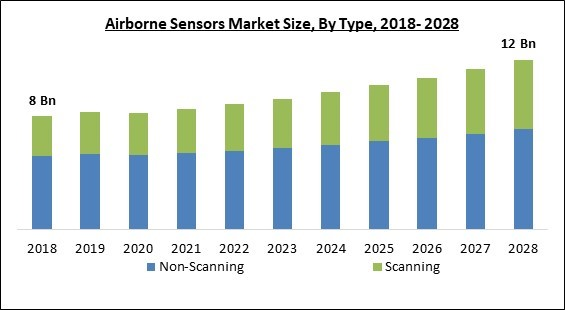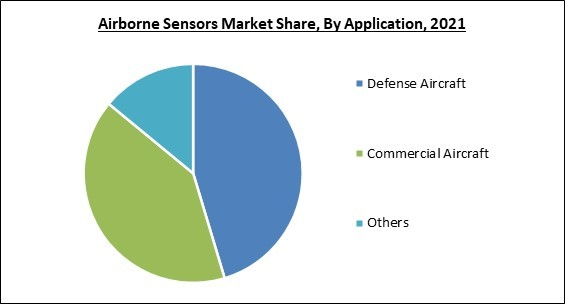Airborne sensors are equipment mounted aboard planes that take photos of the earth's surface. Defense, forestry, agriculture, environment, mapping & survey, mining, infrastructure & urbanization, and many more applications benefit from these sensors. In addition, airborne sensors can provide images with a spatial resolution of 20 cm or less. Airborne sensors are commonly found on planes, drones, floating balloons, helicopters, and jets. Infrared cameras, as well as navigation systems, are used by aircraft having these sensors to take views of the earth's surface. Airborne sensors are used in defense and aerospace, as well as agriculture.
Airborne Sensing has a large fleet of twin-engine aircraft that can carry a variety of sensors. Because aerial mapping necessitates a wide range of capabilities, Airborne Sensing has grown to meet those needs. This comprises aircraft capable of slow flight at low altitudes, which allows for big-scale imaging, as well as aircraft capable of high-speed flying at high altitudes that enables rapid capture of photographs over a large region. The use of only twin-engine aircraft has a number of advantages. Airborne sensing is routinely used over huge swaths of unoccupied land as well as water.
Satellites, aircraft, and terrestrial close-range platforms are the most common platforms used by existing technology. There is a sector of new applications between aerial and terrestrial use, which are often experimental but, in certain circumstances, already well-established and practical. It is possible to obtain data with a resolution and precision that is comparable to that of aerial and terrestrial approaches. The usage of airplanes is sometimes limited by budget and administrative constraints. Other reasons for such uses include flexibility, precision, and scientific interest. These new technologies are capable of competing with traditional ones in some circumstances and have already hit the market.
COVID-19 Impact Analysis
The airborne sensors market was hindered due to the COVID-19 pandemic. Because of industrial closures and supply chain interruptions, the airborne sensor market was significantly hampered during the COVID-19 pandemic. This is primarily due to the supply chain disruption caused by strict lockdowns and the closure of many factories. However, government measures in order to counter the pandemic, as well as contributions from important companies in providing aerial photographs of the Covid-19 pandemic, are expected to drive the airborne sensor market forward in the coming years. Airborne sensors are used in a variety of applications and are continuously being improved. These sensors are very expensive, but they offer a lot of possibilities for gathering data from the air and using it for various purposes. These factors are allowing the market to recover at a faster rate.Market Growth Factors
Higher demand for surveillance drones during the COVID-19 pandemic
The COVID-19 virus has quickly spread around the world. To stop the virus from spreading further, most countries implemented a lockdown. Various people worldwide did not, however, follow the rules in several regions. As a result, law enforcement agencies devised a drone surveillance solution. Police departments all over the world have begun to use drones to track people's movements over large areas without resorting to force. Drones were first used for research in a number of developed countries across the world. Furthermore, a number of UAV manufacturers are working on customized drones that can detect COVID-19 symptoms in crowds.Wide range of uses of these sensors
Once data from airborne sensors, or remote sensors, has been acquired, it can be reused and analyzed for a variety of purposes. Airborne sensors, for example, can collect data to survey a construction site. The same data, on the other hand, may be used to examine and plan new roadways. Alternatively, data acquired from forests to monitor wildfire risk could be utilized to track biodiversity. The reflected light is measured by airborne sensors, which can be natural sunlight or even a light pulse. Airborne sensors do not disrupt the scanned environment because this light is neutral to objects, vegetation, and people.Market Restraining Factors
High cost in small applications and inefficiency during harsh weather conditions
Although LiDAR is inexpensive when used in large applications, it can be costly when utilized to collect data in smaller locations. Sensors, cameras radars, and other components make up the aerial surveillance system. The modern and advanced airborne sensors have the ability to provide precise data. However, due to their sophisticated design, developing airborne sensors become very costly. Due to this, the utilization of these sensors in various small-scale applications is being reduced. Because the components are subjected to harsh weather conditions, the design is complex, which raises the cost.Type Outlook
Based on Type, the market is segmented into Non-Scanning and Scanning. In 2021, the scanning segment garnered a significant revenue share of the airborne sensors market. The increasing growth of the segment is owing to the low cost of this product. Airborne Laser Scanning is a measurement technology in which light pulses (usually produced by a laser) are fired from an instrument mounted on an aircraft and directed in a scanning pattern to the ground.Application Outlook
Based on Application, the market is segmented into Defense Aircraft, Commercial Aircraft, and Others. In 2021, the defence aircraft segment procured the largest revenue share of the airborne sensors market. Key market players who are growing in the aviation business and are adopting new and effective technology to develop airborne sensors for defense applications are majorly bolstering the growth of this segment.Regional Outlook
Based on Regions, the market is segmented into North America, Europe, Asia Pacific, and Latin America, Middle East & Africa. In 2021, North America held a substantial revenue share of the airborne sensors market. This is mostly attributable to the region's defense sector's considerable investment in the development of advanced and next-generation airborne sensors by leading market players.The market research report covers the analysis of key stake holders of the market. Key companies profiled in the report include Honeywell International, Inc., General Dynamics Corporation, Hexagon AB (Leica Geosystems AB), Teledyne Optech, Inc. (Teledyne Technologies Inc.), Thales Group S.A., Raytheon Technologies Corporation, Lockheed Martin Corporation, ITT, Inc., AVT Airborne Sensing GmbH (Vermessung AVT-ZT-GmbH), and Information System laboratories.
Strategies deployed in Airborne Sensors Market
Partnerships, Collaborations and Agreements
- May-2022: Lockheed Martin came into an agreement with Mercury Systems, a leading vendor of secure and trusted mission-critical technologies for defense and aerospace. Under this agreement, the companies is expected to focus on joint development and manufacturing of new sensor processing technologies at the Geneva facility of Mercury Systems.
- Nov-2021: Hexagon’s Geosystems came into a partnership with Airbus, a European multinational aerospace corporation. Through this partnership, the companies aimed to incorporate Hexagon's two Leica Chiroptera 4X bathymetric LiDAR sensors for maritime surveillance with Airbus’C295 MSA.
- Apr-2021: Honeywell teamed up with Pipistrel, a Slovenian light aircraft manufacturer. Following this collaboration, Honeywell is expected to deploy its Air Data Module and advanced Attitude Heading Reference System into the Nuuva V300 cargo unmanned aerial vehicle of Pipistrel to allow the company to provide streamlined and intuitive mouse-click control in order to fly the vehicle and eliminate the requirement for operators to be trained with conventional aviation skills to ensure rapid scale-up of operations for customers.
- Apr-2021: ITT Cannon signed an agreement with Heilind Electronics, a leading distributor of connectors, sensors, and electromechanical products. Under this partnership, ITT cannon is expected to offer its products to Heilind Electronics in order to help the company in expanding its portfolio. Moreover, this agreement also aimed to authorize the sale of these products in markets across America, Asia, and Europe.
- Sep-2020: General Dynamics partnered with Dedrone, a leader in airspace security. Following this partnership, Dedrone is expected to provide the access to complete drone detection and defeat technology of Dedrone to General Dynamics' global network.
- May-2020: Teledyne Optech entered into an agreement with Aerial Surveys International, a precision aerial photography company. Through this agreement, the companies aimed to commercialize Galaxy T2000, upgrade its prevailing versions to a Galaxy T2000 and deploy sensors in the G2 Sensor System.
- Oct-2019: Raytheon teamed up with Korean Air, the largest flag and airline carrier of South Korea. Under this collaboration, the companies aimed to follow the Intelligence Surveillance Target Acquisition and Reconnaissance program of the Republic of Korea's Air Force Raytheon. In addition, Raytheon is expected to become the prime contractor and provider of multiple-intelligence technologies for the aircraft to Korean Air.
Product Launches and Product Expansions:
- Jun-2022: Leica Geosystems unveiled Leica Chiroptera-5, the company's new high-performance airborne bathymetric LiDAR sensor. With this launch, the company aimed to provide high-resolution LiDAR data compatible with various applications, like coastal infrastructure planning, nautical charting, erosion and landslide risk assessments, and nautical charting. Moreover, the new mapping technology accelerates point density, topographic sensitivity, and depth penetration of the sensor in contrast to previous generations.
- Sep-2021: Hexagon’s Geosystems launched Leica ContentMapper, a highly efficient and innovative airborne imaging sensor. Through this launch, the company aimed to offer seamless imaging performance. in addition, the new product offers high performance for content programs, delivering high-resolution imagery at unparallel rates.
- Oct-2020: Thales rolled out AirMaster C, an airborne surveillance radar. The new product comprises equipped with a programmable and ultra-compact SiGe technology-based 2D active antenna and can be leveraged by fixed-wing aircraft, unmanned aerial vehicles, and helicopters detecting the target.
- Aug-2020: Teledyne Optech introduced the CM2000 into its Galaxy offerings. The new sensor is particularly developed for corridor mapping and can provide accurate fine corridor elements information, like railway signs, cellular tower antennas, and fine changes detection ability.
- Feb-2020: AVT released the CM262M a new-generation multi-mission imaging system. The new product is suitable for a multi-mission optic for maritime CUAS and ISR operations. In combination with the eXpeditionary Mobile Air Defense Integrated System, the CM262M delivers enhanced detection, tracking, and identification capabilities of sUAS to more efficiently fight drones at sea.
Acquisitions and Mergers:
- May-2021: Teledyne Technologies acquired FLIR Systems, a designer and manufacturer of thermal imaging sensors and cameras. Following this acquisition, Teledyne is expected to integrate FLIR's capabilities into its portfolio in order to offer a full spectrum of imaging products and technologies along with a complete line of imaging payloads and unmanned systems across all domains spanning from deep space to the deep sea.
Scope of the Study
Market Segments Covered in the Report:
By Type
- Non-Scanning
- Scanning
- Defense Aircraft
- Commercial Aircraft
- Others
- North America
- US
- Canada
- Mexico
- Rest of North America
- Europe
- Germany
- UK
- France
- Russia
- Spain
- Italy
- Rest of Europe
- Asia Pacific
- China
- Japan
- India
- South Korea
- Singapore
- Malaysia
- Rest of Asia Pacific
- LAMEA
- Brazil
- Argentina
- UAE
- Saudi Arabia
- South Africa
- Nigeria
- Rest of LAMEA
Key Market Players
List of Companies Profiled in the Report:
- Honeywell International, Inc.
- General Dynamics Corporation
- Hexagon AB (Leica Geosystems AB)
- Teledyne Optech, Inc. (Teledyne Technologies Inc.)
- Thales Group S.A.
- Raytheon Technologies Corporation
- Lockheed Martin Corporation
- ITT, Inc.
- AVT Airborne Sensing GmbH (Vermessung AVT-ZT-GmbH)
- Information System laboratories
Unique Offerings from the Publisher
- Exhaustive coverage
- The highest number of Market tables and figures
- Subscription-based model available
- Guaranteed best price
- Assured post sales research support with 10% customization free
Table of Contents
Companies Mentioned
- Honeywell International, Inc.
- General Dynamics Corporation
- Hexagon AB (Leica Geosystems AB)
- Teledyne Optech, Inc. (Teledyne Technologies Inc.)
- Thales Group S.A.
- Raytheon Technologies Corporation
- Lockheed Martin Corporation
- ITT, Inc.
- AVT Airborne Sensing GmbH (Vermessung AVT-ZT-GmbH)
- Information System laboratories










